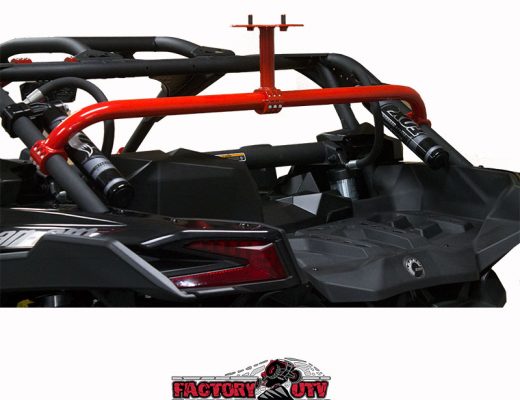By Jon Crowley
We first had the opportunity to test the all-new Can-Am Maverick Sport X RC at Sand Hollow during the Sxs Adventure Rally. I found this new Can-Am rock crawler (this is what the RC stands for) to be very capable in the rocks, especially after a few minor tweaks.
Fast forward a month, and I was headed to Johnson Valley, California, home to King of the Hammers to pre-run for the 2019 race with a few teams including Can-Am racers Phil Blurton and Beau Judge. I brought the Maverick Sport X RC to get some more seat time in a different type of rock crawling terrain, but also wanted to test out a set of brand-new 33x10R15 ITP Coyote tires.
In addition, I added a set of side mirrors since the tire carrier completely blocks rear view. The Can-Am Maverick Sport X RC has a profile cage that is setup for Can-Am window and door accessories, so a normal round clamp does not work. Axia Alloys has a slick clamp setup for these profile cages (see profile cage clamps) so that you can add accessories like side mirrors.
Can-Am Maverick Sport X RC vs. Can-Am Maverick X3 X RC
While running with Phil Blurton in his full size Can-Am Maverick X3 X RC, it was interesting to note several situations where the Sport X RC’s 64-inch width and shorter wheelbase allowed the vehicle to sneak through the rocks, while the Maverick X3 X RC had to climb over them. Take a look at the two videos and you can see how they both performed.
I have always been of the mind that a long travel UTV is just too big for King of the Hammers, but after watching Phil Blurton on some of these trails, I could change my mind. The X3 definitely has the advantage in the rough Johnson Valley desert with its’ longer wheelbase, wider stance and more suspension travel. Plus the larger platform is more steady in some off-camber hill climbs. Then there is the turbo power advantage to consider versus fuel consumption.

The 72-inch width and longer wheelbase on the Can-Am Maverick X3 X RC force it to go over rocks that the Sport X RC can sneak in between.
The Sport X RC shines in the tighter, more technical areas with a narrower width and tighter turning radius. The Sport X RC also has a-arms in the rear instead trailing arms and this allows the rear tires to hit a step up instead of dragging the trailing arm over. At the end of the day, I don’t think the X3 was slowed that much in the tight areas to outweigh the advantages it has in other areas.
Both vehicles have excellent low-range gear ratio, and neither slip a CVT belt, even with larger 32-inch or even 33-inch tires.
Both vehicles also had their front sway bars removed for more articulation in the rocks. Watch both videos and you can definitely see the front tire movement has increased over stock.
I do not like the small diameter wheel studs on the Sport X RC. Much smaller that warranted for a vehicle that comes with 30-inch tires, and I was a bit concerned bumping that up to 33-inch.
Can-Am RC Visibility
Seat position in the Sport X RC is more upright and up higher than the X3 X RC, but neither have very good front visibility. For the X3 X RC, the combination of the long hood and lower seat position make it impossible to see what is coming in many situations. For the Sport X RC, it is more about the hood profile that impedes visibility. If the hood was designed with rock crawling in mind instead of pure aesthetics, it could be lowered quite a bit to allow for a much better field of view. Front field of view is definitely the Achilles’ heel of the Can-Am RC models.




